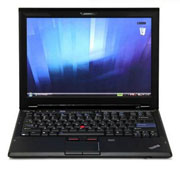 Up on Lenovo’s Inside the Box blog, the ThinkPad X300 designers have posted a comprehensive article about the Lenovo ThinkPad X300 covering, in their words, some of the things you won’t be reading in a review.
Up on Lenovo’s Inside the Box blog, the ThinkPad X300 designers have posted a comprehensive article about the Lenovo ThinkPad X300 covering, in their words, some of the things you won’t be reading in a review.
They literally are things we haven’t seen in any of the reviews or articles about the X300 (and it would appear that many of them could be utilized in a re-designed sequel to the ThinkPad X61 series).
Some of the highlights:
The ThinkPad X300’s paint/covering: The soft touch paint is absolutely intoxicating to run your hand across. It’s unlike any other ThinkPad finish we’ve had before and even better than our black external USB hard disk drives. I’m sure there will be lots of comments about how Kohut’s gone off his rocker, calling ThinkPad a fetish item, but try it out for yourself. You’ll see what I mean.
The bottom of the X300, and user access to user serviceable parts: here are several things that have been improved and are worth noting. First, in direct response to customer feedback, there is one door access to the memory slots, wireless, and mini PCI card slots. Our engineers stopped using one-door access design when the original Roll Cage was introduced in order to give the card slots and memory protection via the Roll Cage. While they accomplished their goal, the drawback was that servicing these was harder than many customers liked. With the X300, ThinkPad engineers figured out how to give both serviceability and protection.
The design of the X300 feet (yes, those little rubber things on the bottom!): The rubber feet deserve special mention. Though the system uses solid state HDDs, the system still needs as much protection as ever from shocks and bumps. These rubber feet are an iterative result of years of research and development (and patents) for protecting ThinkPad systems. There are multiple layers of protection here.
1. The shape of the foot itself. As an experiment, with the same amount of force, poke yourself with one finger and then three fingers in the same spot on your arm. Notice how when you use three fingers, the force is better distributed because it is not focused on a single point. ThinkPads have been using this design point for several generations and I have yet to see another vendor who has figured out this concept, much less implemented it.
2. There are two kinds of rubber. Soft rubber provides maximum cushioning and dampening for minor bumps.
3. Bonded to the soft rubber is a hard rubber. This is needed for harder bumps and falls when the softer rubber “bottoms out.â€
4. The center nib (or nipple, if you insist) is an actual airbag which when depressed under force, acts to control deceleration to minimize damaging forces on the system.
The speakers and keys: The speakers are MUCH improved, which is something we’ve needed to do for a long time. They’re loud and they’re clear. You won’t want to dump your home stereo for them, but if you won’t need to wear a headset to watch a movie in a hotel room any longer. There are other little touches evident throughout. Key buttons like the mute, CapsLock, and power buttons all have LEDs inside to show you when they’re activated.
The “Hybrid Roll Cage II” design: And to those who think that Lenovo has compromised quality by making a machine this thin and light, nothing can be further from the truth. This machine is rock solid (and more importantly, FEELS rock solid) thanks to what we’re calling our Hybrid Roll Cage II design. The top cover consists of layered carbon fibers bonded together with a resin for superior strength. On the sides of the top cover are glass fibers which are necessary to give superior wireless performance. (Glass doesn’t block the wireless signals like carbon fiber and metals do. Other vendors use plastic to get around this issue. That’s what the strip along their top covers is. They are hoping you don’t notice.)
Even if you aren’t interested in the X300, it’s a very interesting read.
